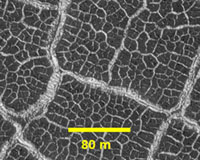 |
Potsdam, Germany (SPX) Sep 23, 2009 The widespread idea that Mars is red due to rocks being rusted by the water that once flooded the red planet may not be correct. Recent laboratory studies show that red dust may be formed by the ongoing grinding of surface rocks and that liquid water need not have played any significant role in the formation process. These findings, which open up the debate about the history of water on Mars and whether it has ever been habitable, have been presented at the European Planetary Science Congress by Dr. Jonathan Merrison. "Mars should really look blackish, between its white polar caps, because most of the rocks at mid-latitudes are basalt. For decades we assumed that the reddish regions on Mars are related to the water-rich early history of the planet and that, at least in some areas, water-bearing heavily oxidized iron minerals are present," said Dr. Merrison, of the Aarhus Mars Simulation Laboratory, Denmark Accurate knowledge of the composition and mineralogy of the planet is vital in understanding the structure and evolution of the near-surface environment and its interaction with the atmosphere, as well as in searching for potential habitats on Mars. Fine red dust covers Mars's surface and is even present in Mars's atmosphere, dominating the weather and sometimes becoming so thick that it plunges the planet into darkness. Even though dust is ubiquitous, we do not fully understand its physical, chemical, and geological properties. In their recent laboratory study, scientists at the Mars Simulation Laboratory have pioneered a novel technique to simulate the sand transport on Mars. They hermetically sealed sand (quartz) samples in glass flasks and mechanically "tumbled" them for several months, turning each flask ten million times. After gently tumbling pure quartz sand for seven months, almost 10% of the sand had been reduced to dust. When scientists added powdered magnetite, an iron oxide present in Martian basalt, to the flasks they were surprised to see it getting redder as the flasks were tumbled. "Reddish-orange material deposits, which resemble mineral mantles known as desert varnish, started appearing on the tumbled flasks. Subsequent analysis of the flask material and dust has shown that the magnetite was transformed into the red mineral hematite, through a completely mechanical process without the presence of water at any stage of this process," said Dr. Merrison. The scientists suspect that, as the quartz sand grains are tumbled around, they get quickly eroded and an alteration of minerals through contact ensues. How exactly this happens needs to be further investigated through more experimental and analytical work. However, the first experiments show that this process occurs not only in air but also in a dried carbon dioxide atmosphere, i.e., in conditions that perfectly resemble those occurring on Mars. It may also imply that the reddish Martian dust is geologically recent. Scientists worldwide, aided by new missions and improved instrumentation reaching the planet, will continue developing new improved computer models and Earth-bound simulators to try to pierce through the red planet's mysteries. "By simulating the conditions and developing accurate analogues of the Martian environment, we will certainly gain a deeper understanding of its dusty nature. In particular, developing better analogues of the Martian surface and atmosphere is vital in interpreting observations made on Mars by landers as well as pioneering the next generation of experiments to be flown," said Dr. Merrison. Share This Article With Planet Earth
Related Links Mars Similation Laboratory EPSC 2009 Mars News and Information at MarsDaily.com Lunar Dreams and more
 Patterns In Mars Crater Floors Give Picture Of Drying Lakes
Patterns In Mars Crater Floors Give Picture Of Drying LakesKatlenburg, Germany (SPX) Sep 17, 2009 Networks of giant polygonal troughs etched across crater basins on Mars have been identified as desiccation cracks caused by evaporating lakes, providing further evidence of a warmer, wetter Martian past. The findings were presented this week at the European Planetary Science Congress by PhD student Mr. M. Ramy El Maarry of the Max Planck Institute for Solar System Research. The ... read more |
|
| The content herein, unless otherwise known to be public domain, are Copyright 1995-2009 - SpaceDaily. AFP and UPI Wire Stories are copyright Agence France-Presse and United Press International. ESA Portal Reports are copyright European Space Agency. All NASA sourced material is public domain. Additional copyrights may apply in whole or part to other bona fide parties. Advertising does not imply endorsement,agreement or approval of any opinions, statements or information provided by SpaceDaily on any Web page published or hosted by SpaceDaily. Privacy Statement |